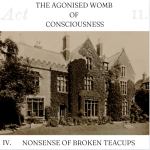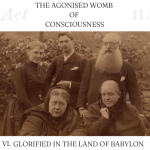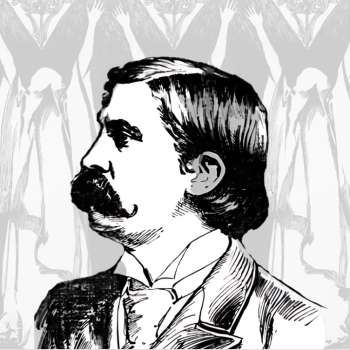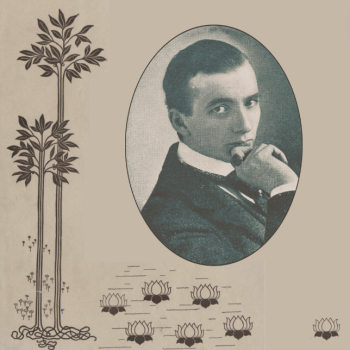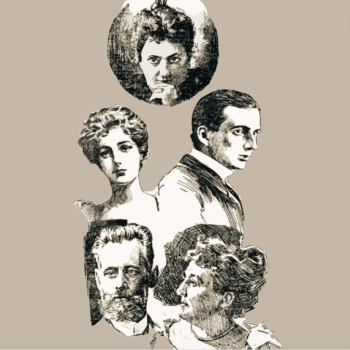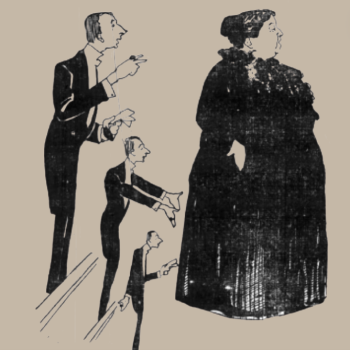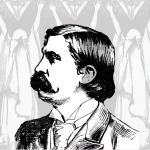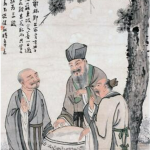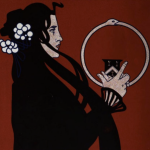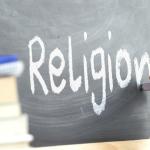A CURIOUS REUNION ON WALNUT STREET
ACT II.
V.
⸻
Govindarao Sattay was among the dozen men, mostly Theosophists, and believers (more or less) in Spiritualism, that were invited to attend the séance of Horatio Eddy on October 13, 1888. The host of the gathering, Henry B. Foulke, was a well-known Philadelphia real estate agent, and recent President locum tenens of the Krishna Branch T.S. (Philadelphia.)[1] He discussed the invitation with W.Q. Judge near the steps of St. Boniface Church, across the street from his home on Duffield Street, and a stone’s throw away from Judge’s home on Willoughby.
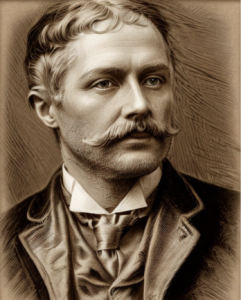
Henry B. Foulke.[2]
“I do not know whether you believe in ghosts or not,” Judge said to Sattay. “I do because I have seen them. I have seen ghosts ever since I was a boy.” Judge thought for a moment. “In a sense we are all ghosts—this ghost of ours is the inner man, or the astral body as it is called by the Theosophical Society.”[3]
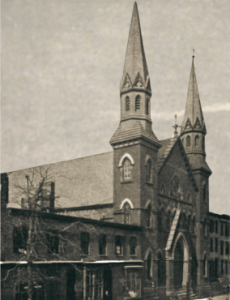
St. Boniface Church. [4]
An early autumn wind whirled a fallen leaf into the air.
“The families on Willoughby Street were once terrorized by boisterous spirits,” said Judge. “I should know, my brother, John, lived at No. 72 at the time.”[5]
The haunting occurred at 112 Willoughby. Jane Smith, her mother, Mrs. Keeler, and their families moved into the house on New Year’s Day, 1878. To offset their living expenses, they took on three young men as boarders. The family immediately began to hear “rappings.” Initially it was faint, “a gentle tapping on the cellar door,” but at midnight the frightening sounds of smashing, and clanging, could be heard throughout the upper stories of the house. Soon the spectral forms of men and women could be seen “flitting about the house.” Occasionally Smith would see the train of a dress sweep around the door of some room. When she quickened her steps to approach it, the appearance simply vanished. Another occupant started down the stairs at three in the morning with lamp in his hand, and as he passed into the hall he saw the form of a tall woman, with drapery about her head, slowly ascending the stairs. He stepped back into his room, and after a few minutes started down again. Once again, he saw the same form moving slowly down the stairs. The noises kept the family in a state of terror. They huddled together around a stove in the basement, and hardly dared to sleep.
The police were eventually informed of the unusual state of things, and the officers on patrol along Willoughby tried to determine the author of the annoyance, but it was in vain. One of the boarders, devoted to ferreting out the mystery, remained up one night, pistol in hand, watching the house for the visitor who must have surely been entering by means of the scuttle. Terrible noises were heard throughout the night, but the hand bell alarm remained silent.
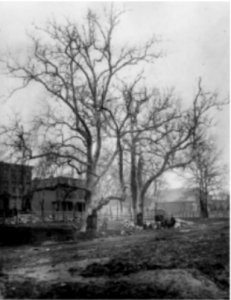
Willoughby Street, Brooklyn, New York c. 1870s.[6]
The strangest of these events occurred two weeks after the family moved in. It was seven in the evening. One of the boarders (the only one who was at all suspected of the mischief,) left the house. Thirty minutes later the “greatest noise was heard.” When the family went upstairs to investigate, they found that the bedding and mattresses on the top story were torn from all the beds and thrown onto the floor. All the chairs had been tossed about, and that “everything had been put in confusion.” Not a soul was in sight. Nothing appeared stolen. The beds were rearranged, and the room was locked, and the doorknob was tied with a stout rope to the baluster in a double sailor’s knot. The family returned to the basement. A short time late a servant was sent upstairs on an errand. She reported, in great fright, that the “devil had been at his work again.” When the family went up to see, they found that the rope had been partly unwound. When they unlocked the door, they found it in the same state of confusion as before. There was one thing different this time. A horseshoe that was hung by a thread inside of the room was missing. This, however, was soon found. It was hanging on one of the front rooms over the door. “How could it have been taken out of the room while the door was securely locked?” they family asked themselves.[7]
This happened a year after John B. Willman (a clergyman of St. Boniface) tore down the old frame buildings on Willoughby Street and replaced them with sturdier brick frames.[8] Perhaps there was a “psychic disturbance” of sorts.
“I don’t confine life to men and animals. I believe that objects and things have life,” said Judge. “All things have astral bodies—even houses.”[9]
“Gopalrao related some personal experiences he had with spirits to me,” said Sattay. “He said that he had seen piles of pots tumble down without cause, and clothing strewn on the floor. On another occasion Gopalrao saw a child of his family lifted from its cot and carried through the air to another part of the room.”
“Is that so?”
“Yes, and one time, while he was sitting in his home and conversing with his household, his sister screamed out that someone was scratching her. ‘What nonsense!’ Gopalrao said. ‘Do you not see that no one is near you?’ ‘Look, look, brother,’ she said, ‘see what is the matter?’ Gopalrao examined her body, and indeed, it was much scratched, and blood was oozing.”[10]
~
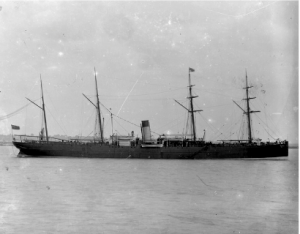
The Persian Monarch. (c/o National Maritime Museum.)[11]
The catalyst which resulted in Foulke inviting Eddy to hold a séance in his home, was the recent revelation of the founders of Spiritualism. On September 28, two weeks after conducting the séance on Cheyne Row, Katie (Fox) Jencken and her boys returned to America on the Persian Monarch.[12] When they arrived on October 9, 1888, Katie learned that her sister, Maggie (Fox) Kane (widow of the Arctic explorer Elisha Kent Kane,) announced that she intended on exposing Spiritualism “from a to izzard.”[13] This took Katie completely by surprise. In May of 1888 the Society for the Prevention of Cruelty to Children (S.P.C.C.) charged Katie with being a “dipsomaniac” (alcoholic,) and neglecting her two boys. Katie was arrested, and her children were placed in the New York Juvenile Asylum.[14] She had good reason to believe that powerful Spiritualists, headed by Leah, the eldest of the Fox sister, had used the S.P.C.C. to persecute her, out of fear of the sisters exposing their secrets. Maggie enlisted the help of other well-connected Spiritualists to help retrieve the boys, and secure Katie’s release. (One of these allies being Isabella Beecher Hooker, sister of Henry Ward Beecher and Harriet Beecher Stowe.)[15] Afraid that another attempt would be made to separate her from her children, Katie made arrangements for hey boys to return to England before their presence was known in New York.[16]
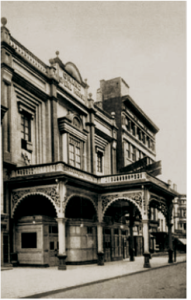
The Grand Opera House, Brooklyn.
On October 28, Maggie would expose Spiritualism at the Grand Opera House, in Brooklyn. Katie, in support of her sister, denounced Spiritualism as well (though she secretly still believed in it.)[17] When the New York press asked Katie about the séances she held in London, she said:
All that took place there of that nature is utterly false. I haven t the slightest idea that the noises which we heard in the house had any connection with Carlyle’s spirit. I certainly know that every so-called manifestation produced through me in London or anywhere else was a fraud. Many a time have I wept because when I was young and innocent, I was brought into such a life. The time has now come for Maggie, and I set ourselves right before the world. Nobody knows at what moment either of us might be taken away. We ought not to leave this base fabric of deceit behind us unexposed.[18]
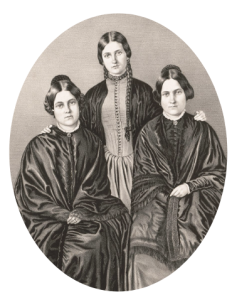
(Left) Maggie Fox. (Center) Katie Fox. (Right) Leah Fox.
Perhaps Katie was just paranoid, or perhaps she was right to be afraid. On October 13, the day that Sattay arrived in Philadelphia for the Eddy séance, the driver of a mysterious carriage tried to abduct Katie and Maggie.[19]
~
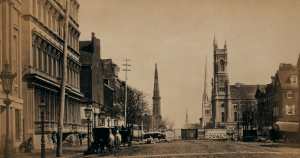
Broad Street, Philadelphia, Pennsylvania.[20]
Horatio Eddy, and his brother, William, held a unique honor in the history of the Theosophical Movement. It was while attending séance on the Eddy farm in Chittenden, Vermont, that Blavatsky and Olcott first met. That was October 14, 1874, one day shy of being fourteen years to the day that Sattay arrived for the séance in the private parlor of Foulke’s Philadelphia home on Eleventh and Walnut.[21] Eddy was now a tall, thin, sun-burned man, who wore a rusty colored suit with a high celluloid collar.[22] In the days since 1874, Eddy remained committed to Spiritualism. In the fall of 1881, Horatio and William rented rooms in Manhattan where they hosted séances throughout the winter.[23] In September 1886 Horatio married a woman named Zelina Hussey, but by the spring of 1887, she had “left [his] bed and board without just cause or provocation.”[24] More recently, during the summer of 1888, Horatio attended the Spiritualist camp meeting at Onset Bay, Massachusetts. Established in 1877, the Onset Bay Grove Association was one of the dozen or so Spiritualist Camp Meeting Associations that had grown in popularity in the 1880s (having been inspired by analogous Protestant camp meeting associations like Ocean Grove, New Jersey.)[25] There he conducted séances where ghostly apparitions emerged from cabinets into dimly lit rooms.[26]
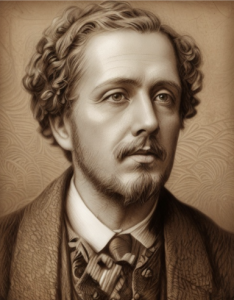
Horatio Eddy.[27]
In one corner of the parlor a curtain was stretched across the wall. Behind it was a table on which banjos, bells, accordions, and a guitar were placed. Eddy was accompanied by his manager and side partner, a very tall and stout man who went by the name “Doc.”
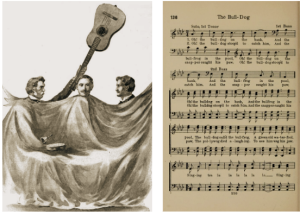
(Left) The Light Séance.[28] (Right) Sheet music for “The Bull-Dog.”
After the audience entered, “Doc” discreetly dimmed the lights. The musical instruments suddenly gave forth a hideous din. The audience struck up a popular song, “The Bulldog on the Bank,” and the spirit orchestra accompanied the tune.
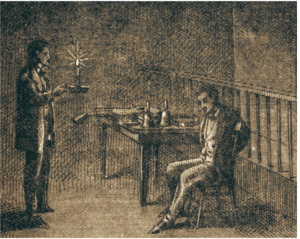
“The ‘Dark Circle.’”[29]
Then a slate was handed over the curtain. Some pencil sounds were heard. A message, with poor grammar and spelling, and indefinite in character, was presented to Eddy. (It is a truism, generally speaking, that penmanship suffers without hands and body.) The medium subsequently deciphered its meaning.
After a long pause, the music began to go around the room. Banjo notes were heard here and there. This part of the séance would have been a grand success if the Philadelphia Times reporter had not suddenly stretched out his leg and tripped a “spirit” as he was hovering about.
“If such an outrage is again attempted, there will be a row,” said the spirit in a voice uncannily like “Doc’s.’”
“The spirits will now answer any questions proposed,” said Eddy.
“Who will be the next mayor of Philadelphia?” one participant asked.
“Politics are out of my line,” replied the spirit, who then offered to improvise some poetry on any subject desired.
“Heroism Under Suffering!” one man shouted.
The spirit fired off a verse or two of doggerel, before giving up. “The subject is no good.”
“Neither is the poetry!” replied the scoffer.
“Doc” raised the lights.
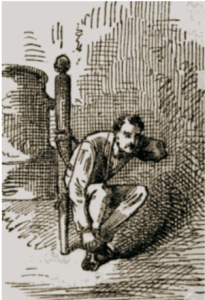
Eddy bound and tied.[30]
The second part of the entertainment consisted in what was called the cabinet manifestation. Eddy was securely bound and placed in an improvised cabinet made up of hangings. The gas was turned out. An old man in the audience struck up “Home, Sweet Home,” and the spirits began to move. The curtains were drawn back, and a figure stuck his head outside the aperture. “I am Mr. Wilson,” said the figure.
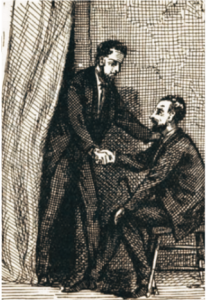
Spirit emerging from behind the curtain.[31]
“Glad to meet you, Mr. Wilson,” an irreverent audience member politely rejoined. “How are you going to vote this election?”
Mr. Wilson withdrew behind the curtain.
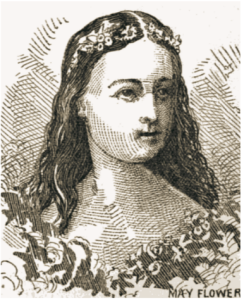
“Mayflower.”[32]
Another song followed, and at the end, “Miss Mayflower,” an eleven-year-old spirit, with a strong Vermont accent made her appearance the stage. Several questions were put to her, but they proved too difficult for her to answer.
Then suddenly, and most peculiarly, three beings began to materialize. These spirits, like Sattay, were dressed in the clothing of India.
Eddy shot a look at “Doc,” who looked back equal perplexed.
“I know these men,” Sattay said aloud. “Rather I knew who these men once were.”
The other participants were transfixed by what they were witnessing.
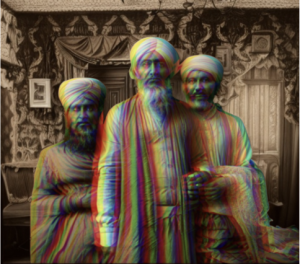
Parlor.
“They were three friends of mine from India,” said Sattay, “three friends who died before my journey to America.”
This curious reunion took a somber tone, when one of Sattay’s spectral companions approached him and whispered:
“Ek pakhavaade mein aap hamaare beech honge.”
Sattay was silent. His eyes tightened with focused introspection.
Neither Eddy, nor “Doc,” nor any of the Theosophists present could understand Hindi and were therefore perplexed at Sattay’s expression.
The spirits dematerialized.
“The conditions of the force have gone back on me,” Eddy declared. “The séance must end.”
“What did the spirits say to you?” Foulke asked Sattay.
“‘Ek pakhavaade mein aap hamaare beech honge,’” Sattay repeated. “They say I will be dead within a fortnight.”
Foulke looked concerned.
“If my spirit is granted the power to return to the land of the living,” Sattay said with resolve, “I will reappear to my friends.”[33]
← →
THE AGONIZED WOMB OF CONSCIOUSNESS SECTIONS: “ACT II”
I. THE LITTLE TOY TEMPLE ON NASSAU STREET.
II. UNION OF HEARTS.
III. IN DARKEST LONDON.
IV. NONSENSE OF BROKEN TEACUPS.
V. A CURIOUS REUNION ON WALNUT STREET.
VI. GLORIFIED IN THE LAND OF BABYLON.
VII. ALWAYS THIN AND GRAVE.
VIII. ET IN ARCADIA EGO.
IX. THEORY OF UTILITY.
X. APOLLO BUNDER.
XII. THE SILENT PASSENGER.
XIII. DECCAN PLATEAU.
SOURCES:
[1] “Theosophical Activities.” The Path. Vol. III., No. 2. (May 1888): 65-66; “Dr. Eddy in Town.” The Philadelphia Times. (Philadelphia, Pennsylvania) October 14, 1888; “Gotham Gossip.” The Daily Picayune. (New Orleans, Louisiana) November 16, 1888; “To Seek Buddha’s Grave.” The Philadelphia Times. (Philadelphia, Pennsylvania) January 16, 1889; “Theosophical Activities.” The Path. Vol. III., No. 9. (December 1888): 298-300.
“The Late Govinda Row Sattay.” Supplement To The Theosophist. (February 1889): xli.
[2] A.I. generated image from: “The Second Christ.” The Philadelphia Inquirer. (Philadelphia, Pennsylvania) June 24, 1894.
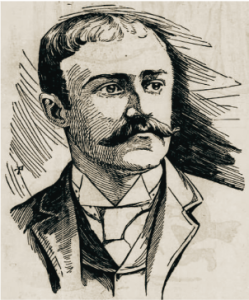
Original.
[3] “Touched By Ghosts.” The Boston Globe. (Boston, Massachusetts) October 15, 1894.
[4] Farley, John Cardinal; Lafort, Remigius (eds.) The Catholic Church in the United States of America. Vol III. The Catholic Editing Company. New York, New York. (1914): 540.
[5] Irma and Paul Milstein Division of United States History, Local History and Genealogy, The New York Public Library. “New York City directory.” New York Public Library Digital Collections.
[6] Brooklyn: Willoughby Street, undated. nyhs_PR024_b-22_f-205_006-01.jpg George P. Hall & Son photograph collection, ca. 1876-1914. Series II: The Bronx, Brooklyn, Queens, and Staten Island. New-York Historical Society. New York, New York.
[7] “Ghosts On A Rampage.” The Sun. (New York, New York) January 6, 1878.
[8] Farley, John Cardinal; Lafort, Remigius (eds.) The Catholic Church in the United States of America. Vol III. The Catholic Editing Company. New York, New York. (1914): 546.
[9] “Touched By Ghosts.” The Boston Globe. (Boston, Massachusetts) October 15, 1894.
[10] “Land of the Brahmins.” The Evening Mail. (Stockton, California) May 21, 1885.
[11] National Maritime Museum, Greenwich, London, Gould Collection.
[12] “The Haunted House In Cheyne-Row.” The Pall Mall Gazette. (London, England) September 10, 1888; “The Mails.” The London Evening Standard. (London, England) September 29, 1888.
[13] “Jottings.” The Boston Evening Transcript. (Boston, Massachusetts) October 1, 1888; “Katy Fox.” The Catholic Union and Times. (Buffalo, New York) October 18, 1888.
[14] D. Appleton and Company. Appletons’ Annual Cyclopædia and Register of Important Events of the Year 1892. D. Appleton and Company. New York, New York. (1893): 547.
[15] “Sudden Death of Kate Fox.” The Philadelphia Inquirer. (Philadelphia, Pennsylvania) July 4, 1892.
[16] “Gotham Gossip.” The Daily Picayune. (New Orleans, Louisiana) October 17, 1888.
[17] On November 17, 1888, Katie Fox (Jencken) wrote a letter to E.A. Cottell stating: “I would have written to you before this, but my surprise was so great on my arrival to hear of Maggie’s exposure of Spiritualism that I had no heart to write to anyone. The manager of the affair engaged the Academy of Music, the very largest place of entertainment in New York City; it was filled to over-flowing. They made 1,500 dollars clear. I have often wished I had remained with you, and if I had the means I would now return, to get out of all this. I think now I could make money in proving that the knockings are not made with the toes. So many people come to me to ask me about this exposure of Maggie’s that I have to deny myself to them. They are bard at work to expose the whole thing if they can; but they certainly cannot. Maggie is giving public exposures in all the large places in America, but I have only seen her once since I arrived.” [“The Foxes and Their Foxing.” Light. Vol. VIII, No. 415 (December 15, 1888): 619.]
[18] Davenport, Reuben Briggs. The Deathblow to Spiritualism. G.W. Dillingham. New York, New York. (1888): 58-59.
[19] “Did Somebody Try To Abduct Them?” The Sun. (New York, New York) October 16, 1888.
[20] Broad Street, Philadelphia, Pennsylvania. Photograph, ca. 1880.
[21] Olcott, Henry Steel. People From the Other World. American Publishing Company. Hartford, Connecticut. (1875): 293; “Dr. Eddy in Town.” The Philadelphia Times. (Philadelphia, Pennsylvania) October 14, 1888.
[22] “Dr. Eddy in Town.” The Philadelphia Times. (Philadelphia, Pennsylvania) October 14, 1888.
[23] “About Town.” The Rutland Daily Herald. (Rutland, Vermont.) November 30, 1881.
[24] “Marriages.” The Rural Vermonter. (Montpelier, Vermont.) October 1, 1886; “Notice.” The Rutland Weekly Herald and Globe. (Rutland, Vermont.) May 19, 1887.
[25] Moore, William D. “‘To Hold Communion with Nature and the Spirit-World’: New England’s Spiritualist Camp Meetings, 1865-1910.” Perspectives in Vernacular Architecture. Vol. VII (1997): 230–248.
[26] “Spirits in Camp.” The Sun. (New York, New York) August 26, 1888.
[27] A.I. generated image from: Olcott, Henry Steel. People From the Other World. American Publishing Company. Hartford, Connecticut. (1875): 19.
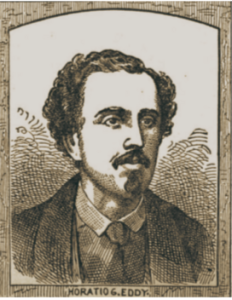
[28] Robinson, William E. Spirit Slate Writing and Kindred Phenomena. Munn & Company. New York, New York. (1898): 102.
[29] Olcott, Henry Steel. People From the Other World. American Publishing Company. Hartford, Connecticut. (1875): 211.
[30] Olcott, Henry Steel. People From the Other World. American Publishing Company. Hartford, Connecticut. (1875): 42.
[31] Olcott, Henry Steel. People From the Other World. American Publishing Company. Hartford, Connecticut. (1875): 199.
[32] Olcott, Henry Steel. People From the Other World. American Publishing Company. Hartford, Connecticut. (1875): 208.
[33] “Gotham Gossip.” The Daily Picayune. (New Orleans, Louisiana) November 16, 1888; “The Late Govinda Row Sattay.” Supplement To The Theosophist. (February 1889): xli.


